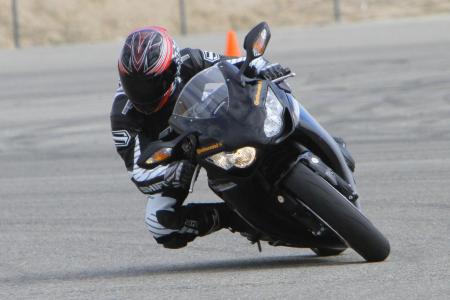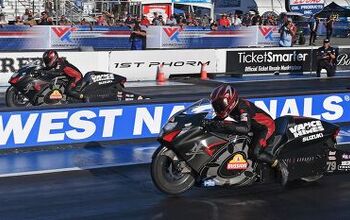2010 Honda CBR1000RR C-ABS Review - Motorcycle.com
Whether it’s simply coincidence, a barometer of the still-weak world economy or a sign of changing OEM methodologies, we’re not exactly sure, but that no significant updates made their way into the crop of Japanese literbikes for 2010 is a matter of fact.
The past year saw two all-new models (the R1 and GSX-R1000) continue the typical two-year development cycle from Japan. Prior to 2010, each new model year generally saw at least one model from the Big Four receive heavy revision. This year is something of a dry spell. But, hey, at least there are a couple changes in the liter class. In the 600cc supersport arena there’s nothing even worth mentioning in terms of revisions for 2010!
With Yamaha and Suzuki supplying clean-slate designs of the R1 and Gixxer 1K in 2009, the round robin revision cycle had us anticipating news of big changes from Honda’s and Kawi’s literbikes. Especially since the last overhaul of each came in 2008. Alas, it was not to be, as Big Red and Team Green implemented only mild updates.
Kawasaki’s ZX-10R received the widest array (and by wide we mean more than two things!) of tweaks and minor but practical refinements. Most notable are improvements to shifting mechanisms, slightly longer throttle cables for improved throttle action and a new Öhlins steering damper. Cosmetic touch ups here and there round out the tart up.
Honda’s CBR1000RR didn’t necessarily stagnate this season, but an unspecified increase in flywheel size, a new muffler cover and revised license plate bracket are just about on par with the Zed’s “news.” So we begrudgingly grant the Honda a status update, but clearly things are slowing down in hyperbike land.
While attending the 2009 U.S. round of WSBK at Utah’s Miller Motorsports Park a Honda rep told me this reeling in of rapid-fire changes might happen for the whole sportbike class, and indeed it seems it has.
No news is good news
We didn’t expect to be able to discern much about a marginally larger flywheel, but to say that we at least tried we took a quick spin around the track. We have to wonder, though, just how much increase was made to the flywheel, as claimed curb weights for the 2008, 2009 and 2010 models are identical at 439 pounds.
We were right. Not much in it to say, “Hey, I’m a new 2010! Not like that stinky ol’ 2009 model! Puh!”
However, a day of beating up on the mostly unchanged 2010 CBR1K only reminded us of all the things we liked so much about last year’s bike.
As we noted in our 2009 Literbike Shootout, the CBR doesn’t post the biggest horsepower numbers, but its wide powerband made it the best street engine of the group. And much of what’s adorable about the Honda’s engine during street rides is also enjoyable and advantageous on the racetrack. A super-stout midrange offers the strongest pull earlier in the rev range than any other literbike. Its torque peak of 76.6 ft-lbs is not only the highest of the 2009 inline-Fours, it also boasts a twisting force advantage over a 5000-rpm range.
Despite grunty power in its midrange, the double-R’s leisurely response at low revs was one of the few things that kept the Honda’s mill from scoring top honors in the Engine category in our annual shootout last year. Seems nothing’s really different in that respect for ’10.
If the flywheel changes for this year were meant to smooth out power delivery, we’d question why, as the Honda had a fairly linear feel to begin with. But a larger flywheel might also have inadvertently served to further soften rev response below, roughly, 6000 rpm. Hard to say since we didn’t have an ’09 to compare to, but nothing about this year’s engine screams big changes for the better. We’re awaiting responses from Honda for details on the flywheel…
One attribute about the CBR that testers lauded last year was its stable, obedient chassis. We can look not so fondly back to Mark Gardiner’s mishap as a strange testament, almost a backhanded compliment if you will, to the Honda’s handling.
“It [Honda] felt so planted and confidence-inspiring that I crashed it,” said a red-faced Gardiner. “That’s a compliment to the brilliant handling; lesser bikes send you a warning as you reach the limits of the tire’s adhesion, but the CBR1000RR was completely composed, ready to do much more on demand.”
Nothing has changed about the 1000’s frame, steering geometry, etcetera, so it remains a well-handling sportbike. We won’t, however, be crashing another one this year as an exercise to celebrate the Honda’s chassis…
Last year I had the grand opportunity to sample Honda’s new Combined-ABS for sportbikes when I test rode the 2009 CBR600RR C-ABS at Honda’s private testing facility. I couldn’t say enough good things about the new system, as you can read here in our 2009 CBR600RR C-ABS Review. However, we forsook using the CBR1000RR with C-ABS in last year’s liter battle. That meant I was the only rider here to have had the pleasure or riding the computer-controlled ABS for Honda supersports.
This year we seized the opportunity to ride the C-ABS-equipped thousand, giving Kevin Duke his first taste of the system.
“The Combined part of the C-ABS works really well on the track,” remarked KD on his first experience with the linked anti-locks.
“Hard-braking situations that would have other bikes wagging their back ends during corner entry were utterly composed with the CBR’s system. The way the addition of a slight amount of rear brake settles the chassis when braking provides a feeling of security, regardless of the safety aspects of the ABS part of the system. If I were in the market for a CBR1000RR, I wouldn’t hesitate to choose the C-ABS version.”
Ultimately there’s not a lot to parade about as big changes for the CBR, unless you want to talk dollars.
The Honda’s MSRP has bumped up to $13,399 for 2010, a $400 increase from 2009. But the 2010 bike’s tag reflects a full $1800 over the 2008 model. That’s a sizable leap for what is essentially the same bike as two years ago. Eesh! Seems Japan is still having a tough go of it.
Regardless of a dearth of impressive updates, the CBR1000RR is still an excellent bike. And with the same condition across the class this year we’ve no reason to expect the Honda wouldn’t come out the overall winner in 2010 against Kawasaki, Suzuki and Yamaha, just like it did in last year’s shootout.
However, there’s a new inline-Four kid in town. And by judging recent feedback about the performance of BMW’s S1000RR, we expect the Big Four are all back at the drawing board feverishly penning new literbikes.
Stay tuned to find out how the uber-powerful new Beemer stacks up against its rivals!
Related Reading
2010 Hondas Revealed
2009 Literbike Shootout
2008 Honda CBR1000RR Review
2010 BMW S1000RR Review
Best of 2009 – Motorcycles of the Year
All Things Honda on Motorcycle.com
More by Pete Brissette

































Comments
Join the conversation